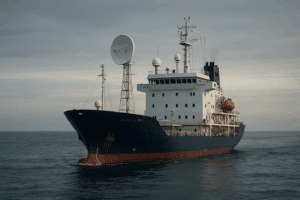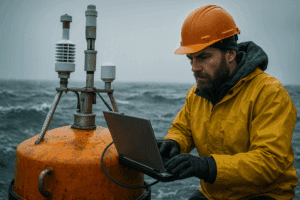The container shipping industry is a cornerstone of global trade, moving billions of tons of goods annually.
Did you know that 90% of global goods are transported by sea? This staggering figure underscores the importance of maritime operations in sustaining global commerce.
Given the complexity of operations, visual monitoring systems play a crucial role in ensuring safety, efficiency, and security. With advancements in computer vision, deep learning, and image analysis, these technologies have evolved to address diverse applications such as cargo management, vessel tracking, port security, and real-time monitoring. This article provides a detailed overview of the different types of advanced observation tools, emphasizing their practical applications in container shipping.
How visual monitoring transforms maritime operations
Visual monitoring systems have become indispensable in the container shipping industry, offering solutions for security, efficiency, and environmental compliance. These tools encompass a broad spectrum of technologies designed to collect and analyze video data for various purposes, such as object detection, tracking, and physical verification. From camera-based surveillance hardware, state-of-the-art algorithms, and intelligent deep learning-based analysis, these technologies provide actionable insights that reshape maritime operations.
Beyond their core functions, visual monitoring systems also play a role in optimizing maritime logistics. By integrating these technologies with other digital systems, such as automated port management software, stakeholders can improve scheduling, minimize downtime, and reduce operational costs. This seamless integration is a key driver of efficiency in the modern maritime shipping industry.
Enhanced security onshore and onboard with advanced surveillance systems
Ports are high-risk zones due to the extensive cargo traffic, numerous personnel, and frequent ship arrivals, making them potential hotspots for unauthorized activities. Advanced video surveillance systems enhance security by ensuring that activities are closely monitored, suspicious behaviors are detected early, and unauthorized access is prevented. These systems rely on multi-camera setups integrated with computer vision algorithms to achieve their objectives.
Comprehensive real-time port surveillance
At major ports like the Port of Rotterdam, sophisticated multi-camera systems have become indispensable. By combining real-time video data with deep learning-based object detection, these systems accurately identify unregistered vehicles, trespassers, or unusual movements within areas prone to theft, such as cargo storage zones and loading docks. Alerts generated by object detection algorithms are directly relayed to security personnel, enabling rapid intervention, and ensuring minimal disruption to operations in a more secure environment. By accurately flagging anomalies, this contributes to a significant drop in incidents.
Another important benefit of port surveillance systems is compliance with international security standards, such as the International Ship and Port Facility Security (ISPS) Code. These advanced systems ensure that ports meet global safety requirements, reducing the risk of sanctions and improving their reputation in global trade.
Shipboard surveillance for increased vessel safety
Security challenges extend to vessels themselves. Onboard monitoring systems utilize multi-camera setups to oversee critical operations like cargo handling, deck activities, and access to sensitive areas. These systems are vital for detecting irregularities such as improper loading practices, hazardous spillage, or unauthorized entry.
Onboard systems also contribute to crew safety by identifying potential hazards during operations, such as slippery surfaces or dangerous cargo handling practices. By monitoring and alerting crew members in real time, these systems significantly reduce workplace accidents.
Smart solutions for cargo management and inspection
Efficient cargo operations are a cornerstone of port productivity. Leveraging advanced vision-based systems, stakeholders can streamline cargo inspections, ensure the integrity of containers, and maintain supply chain transparency.
Revolutionizing container inspections with vision-based automation
Containers endure harsh conditions during transportation, which can lead to physical damage. Camera-based monitoring systems with deep learning algorithms capture detailed image data to assess container integrity. Issues such as dents, rust, or structural damage are automatically identified, reducing dependence on manual inspections. Automated defect detection not only enhances accuracy but also significantly cuts inspection times.
By reducing human error, automated inspection systems improve the reliability of damage assessments. This accuracy is crucial for insurance claims, as precise documentation of container conditions minimizes disputes between shipping companies and their clients.
Streamlining supply chain operations with precise container tracking
Tracking container movement is critical for maintaining transparency and timely deliveries. Computer vision applications and state-of-the-art tracking algorithms enable stakeholders to receive real-time updates on container locations. Delayed or misplaced shipments trigger alerts, allowing for swift corrective actions. Some systems integrate predictive analytics to estimate delivery times based on historical patterns, weather conditions, and traffic data, offering greater reliability.
In addition to enhancing visibility, container tracking systems also enable better collaboration among supply chain stakeholders. Sharing real-time data with suppliers, logistics companies, and port authorities ensures smoother coordination and faster problem resolution.

Boosting port operations with intelligent automation
Automation in ports has revolutionized traditional processes, reducing delays and enhancing throughput. Intelligent visual monitoring systems are at the heart of this transformation.
Smart crane operations and container stacking
Automated terminals rely on computer vision applications to guide cranes in stacking and transferring containers. These systems minimize errors, ensuring that containers are correctly placed and ready for the next stage of transportation. At the Port of Los Angeles, a deep learning-based monitoring system improved crane coordination, increasing throughput by 20% annually.
Moreover, smart crane systems reduce energy consumption by optimizing crane movements. This contributes to the sustainability goals of ports, aligning with the industry’s push for greener operations.
Predictive maintenance for port equipment
Monitoring equipment health, such as cranes and conveyor belts, is critical to preventing costly downtime. Camera-based systems analyze video data to identify signs of wear and predict maintenance needs. This proactive approach avoids breakdowns and extends the lifespan of machinery.
Integrating predictive maintenance with IoT sensors further enhances its effectiveness. These systems not only monitor visual data but also collect real-time performance metrics, providing a holistic view of equipment health.
Using Data to Showcase Benefits
Visual monitoring systems have driven transformative results in the maritime industry. For example:
- Ports equipped with these technologies have seen a 40% reduction in cargo theft incidents.
- Automated crane systems guided by monitoring have improved container throughput by 20% annually.
- Predictive maintenance has reduced equipment downtime by 30%, saving significant operational costs.
By integrating these solutions, the maritime shipping industry is enhancing efficiency and achieving measurable improvements in safety and cost management.
Enhancing vessel traffic and navigation with cutting-edge technology
Efficient maritime traffic management is vital for avoiding congestion, ensuring safety, and optimizing docking processes. Camera-based systems and computer vision algorithms enable ports and shipping lines to manage vessel movements with unprecedented precision.
Improving safety and efficiency across busy maritime routes
Advanced systems track vessel speed, position, and movement patterns. This data is used to predict potential collisions or bottlenecks, allowing for preemptive measures. Additionally, some systems include visual verification bridges, which cross-reference vessel identities with shipping manifests, ensuring compliance with regulations. Hence, real-time tracking not only aids in operational efficiency but also assists port authorities in monitoring compliance with maritime safety standards.
Docking assistance for seamless cargo transfers
Accurate docking is crucial for the seamless transfer of goods and passenger safety. Video monitoring systems integrated with object detection technologies guide vessels to their docking points with precision, reducing the risk of accidents and delays.
Favoring a cleaner and safer maritime environment
In a different tone, environmental sustainability is a growing priority for the shipping industry, as it works to reduce its environmental footprint. Visual monitoring systems play a pivotal role in addressing pollution, monitoring emissions, and ensuring compliance with environmental regulations.
Oil spill and emission detection
Visual systems with deep learning-based image analysis are used to detect oil leaks and monitor emissions. These systems can differentiate between normal activities and potential hazards, ensuring quick responses to environmental threats.
Example: A port authority reduced response times to oil spills by 50% using an automated monitoring system. The system detected unusual water surface patterns, signaling leaks before they could spread widely.
Weather monitoring and predictive insights
Adverse weather poses risks to vessels and cargo. Video surveillance systems integrated with state-of-the-art algorithms help businesses stay ahead of adverse conditions. To do so, they analyze real-time weather data to forecast storms, high winds, or other hazards. This information allows vessels to adjust their routes and prevent potential accidents.
What are the game-changing technologies in the world of visual monitoring?
Beyond automation, technological advancements continue to redefine visual monitoring systems. Emerging technologies like deep learning and cloud computing are driving the evolution of such solutions, making them more intelligent, scalable, and efficient.
Deep Learning for enhanced analysis
Systems leveraging convolutional neural networks (CNNs) can detect patterns, anomalies, and objects with remarkable accuracy. This capability allows for proactive issue resolution, such as identifying potential hazards before they escalate.
Cloud-based monitoring for centralized insights
Cloud technology enables the storage and processing of video data across multiple locations, offering centralized access to stakeholders. Shipping agents, forwarders, and port operators can collaborate more effectively using real-time insights.
The emerging market trends in maritime visual monitoring systems
These innovations also align with emerging market demands and trends. The global market for visual monitoring systems is expanding rapidly, fueled by technological innovation and the demand for more efficient maritime operations.
IoT integration
IoT-enabled systems improve connectivity, allowing sensors, cameras, and databases to communicate seamlessly. This enhances data accuracy and provides actionable insights for all stakeholders.
AI-Powered analytics
AI technologies are becoming indispensable for processing large volumes of video data efficiently. They enable deeper insights into port operations, environmental conditions, and equipment performance.
Affordable solutions
The development of cost-effective options by companies like Radiant Vision Systems ensure that even smaller operators can access advanced technologies, democratizing the benefits of visual monitoring.
As the monitoring system market continues to evolve, stakeholders in the industry must leverage these advancements to stay competitive and ensure the smooth flow of global trade. By adopting cutting-edge computer vision systems and vision-based monitoring solutions, the maritime sector can achieve new levels of innovation and reliability
FAQ about Visual Monitoring
Visual monitoring involves the use of advanced camera systems, computer vision, and deep learning technologies to oversee and manage various aspects of maritime operations. It plays a crucial role in ensuring safety, enhancing port security, improving cargo management, and maintaining environmental compliance in the shipping industry.
These systems use multi-camera setups and deep learning-based algorithms to monitor port activities in real time. They detect unauthorized access, track unusual movements, and provide alerts for potential security threats, ensuring that ports operate safely and efficiently.
Yes, visual monitoring systems equipped with advanced image analysis can automate container inspections. They detect physical damage such as dents or rust and ensure container integrity. This reduces reliance on manual checks, increases accuracy, and saves time during cargo operations.
Visual monitoring systems help detect oil spills, monitor emissions, and ensure compliance with environmental regulations. By identifying potential hazards early, they enable rapid response and contribute to reducing the environmental impact of maritime operations.
Recent advancements include deep learning algorithms for enhanced object detection, IoT-enabled systems for better connectivity, and cloud-based platforms for centralized data access. These innovations make visual monitoring solutions more intelligent, scalable, and efficient for the shipping industry.


